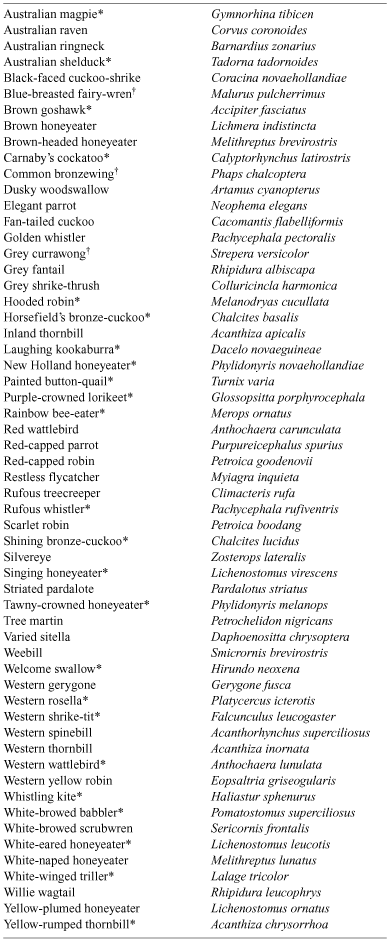Habitat complexity explains species-specific occupancy but not species richness in a Western Australian woodland
Jarrad A. Cousin A D and Ryan D. Phillips B CA Centre for Ecosystem Management, School of Natural Sciences, Edith Cowan University, Joondalup, WA 6027, Australia.
B Kings Park and Botanic Garden, The Botanic Garden and Parks Authority, West Perth, WA 6005, Australia.
C School of Plant Biology, University of Western Australia, Nedlands, WA 6009, Australia.
D Corresponding author. Present address: School of Environment, Griffith University, Nathan, Qld 4111, Australia. Email: jcousin@graduate.uwa.edu.au
Australian Journal of Zoology 56(2) 95-102 https://doi.org/10.1071/ZO07065
Submitted: 3 December 2007 Accepted: 19 June 2008 Published: 9 September 2008
Abstract
Habitat complexity is an important factor governing species richness and habitat selection in birds. The present study examined this relationship in a large wandoo woodland in Western Australia. Habitat complexity (comprising canopy, shrub, ground vegetation, log and leaf litter cover) and bird species richness was recorded in 48 sites, each ~3 ha in size. We found no significant correlation of habitat complexity with species richness. We propose that the absence of such a relationship results from the resource-poor environment of the woodlands of south-western Australia. The relative scarcity of food resources results in a species richness threshold beyond which there are insufficient niches and resources to support additional species with increasing habitat complexity. Only two species exhibited significant associations with habitat complexity, with the western yellow robin (Eopsaltria griseogularis) occupying sites with higher habitat complexity, and the restless flycatcher (Myiagra inquieta) occupying sites with lower habitat complexity. Although some species may respond specifically to habitat complexity, management of avian biodiversity within Australian woodlands should take into account the potentially greater role that productivity and resource availability play in influencing species richness, rather than habitat complexity per se. Furthermore, the individual components comprising habitat complexity may be of equal importance in assessing relationship of species richness to overall habitat complexity.
Acknowledgements
We thank Dr Stuart Cairns from the University of New England (UNE) for help with statistical analysis. Birds Australia provided financial assistance through the Stuart Leslie Bird Research Award, as did the Centre for Ecosystem Management at Edith Cowan University. Thank you also to Professor Hugh Ford (UNE), Dr Veronica Doerr (CSIRO, Canberra) and three anonymous reviewers for comments on earlier versions of the manuscript.
Ammon, E. M. , and Stacey, P. B. (1997). Avian nest success in relation to past grazing regimes in a montane riparian system. The Condor 99, 7–13.
| Crossref | GoogleScholarGoogle Scholar |
Braithwaite, L. W. , Austin, M. P. , Clayton, M. , Turner, J. , and Nicholls, A. O. (1989). On predicting the presence of birds in Eucalyptus forest types. Biological Conservation 50, 33–50.
| Crossref | GoogleScholarGoogle Scholar |
Coops, N. C. , and Catling, P. C. (2000). Estimating forest complexity in relation to time since fire. Austral Ecology 25, 344–351.
| Crossref | GoogleScholarGoogle Scholar |
Ford, H. A. , Barrett, G. W. , Saunders, D. A. , and Recher, H. F. (2001). Why have birds in the woodlands of southern Australia declined? Biological Conservation 97, 71–88.
| Crossref | GoogleScholarGoogle Scholar |
Hildén, O. (1965). Habitat selection in birds: a review. Annales Zoologici Fennici 2, 54–75.
Recher, H. F. , and Davis, W. E. (1998). The foraging profile of a wandoo woodland avifauna in early spring. Australian Journal of Ecology 23, 514–527.
| Crossref | GoogleScholarGoogle Scholar |
Vittinghoff, E. , and McCulloch, C. E. (2007). Relaxing the rule of ten events per variable in logistic and Cox regression. American Journal of Epidemiology 165, 710–718.
| Crossref | GoogleScholarGoogle Scholar | PubMed |

Watson, J. , Freudenberger, D. , and Paull, D. (2001). An assessment of the focal-species approach for conserving birds in variegated landscapes in southeastern Australia. Conservation Biology 15, 1364–1373.
| Crossref | GoogleScholarGoogle Scholar |

Watson, J. , Watson, A. , Paull, D. , and Freudenberger, D. (2003). Woodland fragmentation is causing the decline of species and functional groups of birds in southeastern Australia. Pacific Conservation Biology 8, 261–270.

Watson, J. E. M. , Whittaker, R. J. , and Dawson, T. P. (2004). Habitat structure and proximity to forest edge affect the abundance and distribution of forest-dependent birds in tropical coastal forests of southern Madagascar. Biological Conservation 120, 311–327.
| Crossref | GoogleScholarGoogle Scholar |

Wiens, J. A. , and Rotenberry, J. T. (1981). Habitat associations and community structure of birds in shrubsteppe environments. Ecological Monographs 51, 21–41.
| Crossref | GoogleScholarGoogle Scholar |

Willett, T. R. (2001). Spiders and other arthropods as indicators in old-growth versus logged redwood stands. Restoration Ecology 9, 410–420.
| Crossref | GoogleScholarGoogle Scholar |

Williams, R. J. (1990). Cattle grazing within subalpine heathland and grassland communities in the Bogong High Plains: disturbance, regeneration and the shrub–grass balance. Proceedings of the Ecological Society of Australia 16, 255–265.

Willson, M. F. (1974). Avian community organization and habitat structure. Ecology 55, 1017–1029.
| Crossref | GoogleScholarGoogle Scholar |


|


